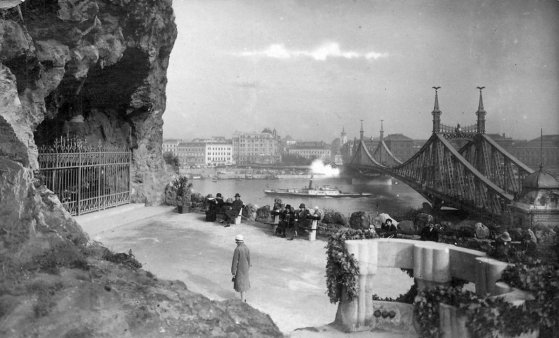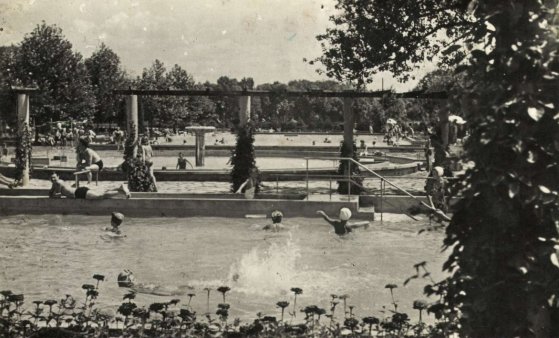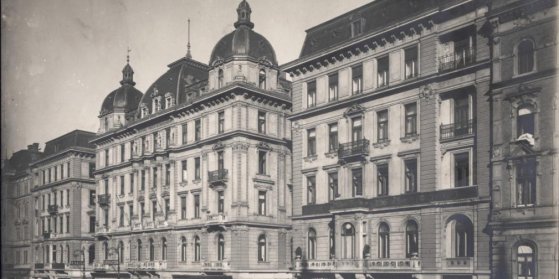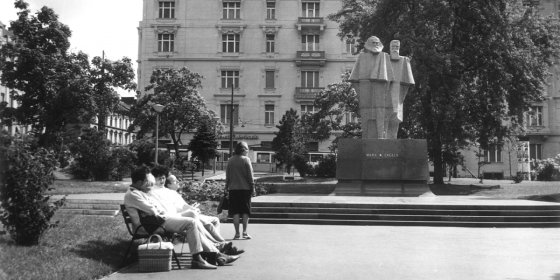 The „intertwined history” of the bridges and the city of Budapest
Which ideas and events have shaped the fate of bridges of Budapest and the cityscape? Alongside many other interesting facts, this question is also answered this newly published book by the Budapest City Archives, which introduces the history of bridges in Budapest.
The „intertwined history” of the bridges and the city of Budapest
Which ideas and events have shaped the fate of bridges of Budapest and the cityscape? Alongside many other interesting facts, this question is also answered this newly published book by the Budapest City Archives, which introduces the history of bridges in Budapest.
histories
 160 years ago, the city of Pest declared war on dirt roads
160 years ago, the city of Pest declared war on dirt roads
June 11, 2021 at 9:00 AM
Today, Budapest's road network typically consists of paved roads. Although there are still dirt roads, their number is constantly decreasing. In Budapest, the paving of streets started relatively late, but 160 years ago, the city of Pest adopted a decree on what paved roads should look like.
One hundred and fifty years ago, the law on the construction of the Outer Ring Road was given royal consent
June 9, 2021 at 9:00 AM
A flood drain, a navigable waterway serving industrial sites, or a more elegant route? In the 19th century, several plans were made for the location of the Outer Ring Road. The issue was closed by law 150 years ago.
Neons lost – Many billboards on Rákóczi Road are reminiscent of old times
June 8, 2021 at 9:00 AM
Hundreds of neon signs used to fill Budapest at night with colourful light. However, the lamps constantly needing to be maintained and wasting energy were replaced by more modern advertisements decades ago. However, many of the advertising signs or their rusty remnants can still be seen in their original place to this day, damaging the cityscape.
The first gas lamp in Pest was lit 205 years ago
June 3, 2021 at 9:00 AM
The aldermen of Pest were given plenty to think about when providing night lighting on the city streets in the 18th century, so in 1715, they forbade staying on the street without a candle or lantern after sunset. Lantern-bearers appeared, carrying candles and oil lamps in front of pedestrians. Oil lamps began to be put out in public spaces at the end of the century, but they only gave little light. The solution was the gas lamp, the first of which was set up in Pest by a scientist, experimenting physician, Lajos Tehel, on 5 June 1816. The lamp was lit up on the facade of the university building on today’s Egyetem Square. Now it is part of the National Museum’s collection.
Timing trouble – The difficulties of introducing a 24-hour clock system
June 1, 2021 at 9:00 AM
Today, it is natural for a train to depart Nyugati Railway Station not at 1 pm, but at 13:00, but on 1 June 1921, this was a surprising novelty. The 24-hour clock system, introduced a hundred years ago, was unusual for the people of Budapest even years later. However, even clock faces were redesigned because of the change.
Vehicle entry to Buda Castle first restricted 35 years ago
May 31, 2021 at 3:00 PM
Today car access to the castle is limited, and only midi-buses run within its ancient walls. Restrictions on access were introduced 35 years ago because traffic endangered historic buildings and the caves beneath the streets of the castle.
The first Children's Day in Budapest was held 115 years ago - Fundraising has continued for impoverished Children till today
May 30, 2021 at 9:00 AM
One hundred and fifteen years ago, in 1906, Children's Day was first held in Budapest and we would be very surprised if we could go back in time to the streets of the capital with the help of a time machine. The event was actually a relief operation for the benefit of orphaned and ill-fated children, but it was all accompanied by a public festival that, according to contemporary accounts and images, moved every stratum of society. The most distinguished women sat next to the fundraising boxes, musicians and stuntmen marched in the streets, and a multitude of people had fun and donated generously.
Campaign launched against rats 90 years ago in Budapest
May 28, 2021 at 10:00 AM
A war against rats was launched in the capital in 1931, but a mistake slipped into the thorough and long-planned campaign. Fewer rats died than planned, and there were many "civilian" casualties, like dogs, cats, and birds.
Metro escalator tested in Hűvösvölgy terminus of the Children's Railway
May 27, 2021 at 10:00 AM
An escalator transported passengers for a few years from May 1956 at the Hűvösvölgy terminus of the Children's Railway. It was built as a kind of test. Its primary purpose was not to ensure the comfort of the passengers on the Children's Railway, then called the Pioneer Railway, but to educate the operators and users. At the time, the Budapest metro was already under construction, and the escalator needed testing too.
A place of worship in a cave – Cave Church turns 90
May 24, 2021 at 2:00 PM
One might think that the Cave Church on the side of Gellért Hill is an old church, although it is surprisingly young, not a hundred years old, as construction of the chapel itself began in 1924 and it was consecrated in 1931. During the communist era, a reinforced concrete wall closed it off from worshippers, which was only demolished in 1992.
Medicinal water was found on Whitsun in the area of today's Pünkösdfürdő Bath
May 24, 2021 at 9:00 AM
The story is almost like a fairy tale because from the moment Sándor Ember, a legal adviser, and later Member of Parliament accidentally learned about the intention to parcel the area near Békásmegyer during a rowing tour on the Danube and bought the land after a quick decision, it was as if everything turned into gold. It soon became clear that the area had unparalleled archaeological finds across Europe and then on Whitsun in 1934, medicinal water was found on the plot, where soon, in the summer of 1935, a bath now known as Pünkösdfürdő ('Whitsun Bath') opened.
The charming boathouses of Római-part have disappeared
May 21, 2021 at 9:00 AM
The Római-part (Roman Beach) was already a popular resting place on the Danube in the 1900s, and it became really popular in the 1920s. The former boathouses tell us about our architectural, sports and cultural-historical values – today mostly only from photographs.
Remains of Hadrian's palace on Hajógyári Island were found 170 years ago
May 20, 2021 at 10:00 AM
Hadrian was one of the most successful emperors of the Roman Empire. Once, he was the governor of the province of Pannonia. His governor's palace, built in the 2nd century, was in the settlement of Aquincum. The remains of the former huge building were discovered 170 years ago when the Óbuda shipyard expanded its site. The ruins have since been excavated several times on today's Hajógyári (Shipyard) Island.
Food kitchens alleviated the misery of the war in Budapest 105 years ago
May 17, 2021 at 9:00 AM
Although World War I did not directly affect the home front, Budapest was not bombed by the enemy like in World War II, but because of the battles, the capital was struggling. In 1916, the state wanted to help. Food kitchens were set up to deliver vegetable dishes and pasta to the poorer quarters of Budapest.
The man who drilled the artesian wells of Budapest - Vilmos Zsigmondy was born 200 years ago
May 16, 2021 at 11:00 AM
Budapest owes a lot to Vilmos Zsigmondy: the enterprising mining engineer was one of the first international experts to successfully extract thermal resources in Hungary. He drilled the artesian well of Margaret Island. The drilling of one of the deepest wells in the world at the time, almost a kilometre away, in City Park, which made it possible to open the Széchenyi Baths, is also connected to his name.
A Tuscan cast many iconic sculptures in Budapest
May 15, 2021 at 11:00 AM
Many foreign masters made a significant contribution to the development of Budapest city. Professionals from German-speaking countries excelled in the fields of architecture and applied arts in particular. A somewhat forgotten master who chose the Hungarian capital as his homeland instead of sunny Tuscany is worth noting. Raffaelo Vignali, or Rafael Vignáli in Hungarian, came to Budapest for the works of the Millennium Monument.
Construction of blue Metro Line M3 began 50 years ago
May 13, 2021 at 9:00 AM
The development of the Budapest underground network entered a new phase 50 years ago when the construction of the city’s third metro line began. Although the ideas changed a lot and the work planned for 15 years took 20, today’s Metro Line 3 is one of Budapest's most important transport corridors.
Tündérbérc to house children's camp again
May 12, 2021 at 9:00 AM
The name of Csillebérc is still associated with the former pioneer camp and the children's railway. Children spent their holidays in the camp known as Pioneer Republic, and later Csillebérc Pioneer Camp, from 1948. Eventually, a lawsuit that lasted 15 years from the 2000s settled the ownership of the area. Soon, a children's camp will open on Csillebérc again.
The Royal Hotel hosted the first film screening in Hungary 125 years ago
May 11, 2021 at 9:00 AM
Fortunately, the Hungarian Academy of Sciences set the date of the Hungarian conquest of the Carpathian Basin as 896, rather than the originally planned 895. In 1896, the official national millennium was celebrated with miracles such as the first domestic film screenings. The general public could see the screenings in two places: that of the Lumière brothers were held at the Royal Hotel, and Edison’s were shown in Lágymányos.
Shortest suburban railway line in Budapest turns 70
May 7, 2021 at 10:00 AM
Suburban railway lines (HÉV - helyiérdekű vasút) have been running from Boráros Square to the 21st District for seventy years. Csepel had a rapid transit connection before, with trains running on Gubacsi Bridge. The suburban railway line to Csepel is record-breaking in many aspects: it is the shortest line, the site of the most serious accident, and currently home to the oldest trains.
Neither Pest nor Buda wanted a private company to build the first bridge in Budapest – the bridge law is 185 years old
May 4, 2021 at 9:00 AM
A law promulgated 185 years ago made it possible to build the first permanent Danube bridge connecting Buda and Pest. A long debate preceded the adoption of the bridge law because neither Pest nor Buda supported a private company building the bridge, as they did not want to waive their customs rights.
Tivadar Puskás built the first Hungarian telephone exchange 140 years ago
May 3, 2021 at 9:00 AM
The first telephone exchange started operating in Budapest on May 1, 1881. Tivadar Puskás and his brother Ferenc built the equipment. Initially, the phone centre had only 25 subscribers, but its popularity grew steadily. Based on the telephone network and the telephone exchange, Tivadar Puskás's truly great invention, the Telephone Herald (Telefonhírmondó), was born and presented at the Millennium Exhibition.
Celebrating the millennial past of the Hungarian nation
May 1, 2021 at 4:00 PM
The central event of the millennium celebrations of 1896, held on the anniversary of the Hungarian Conquest of the Carpathian Basin, was the National Millennium Exhibition held in City Park. The exhibition, which was open for half a year, offered insight into the past of Hungarians and provided an opportunity to present the results achieved during the extraordinary economic development after the Austro-Hungarian Compromise.
Second life for the bridges of Budapest?
April 30, 2021 at 9:00 AM
Recently, an announcement was published about reusing the pieces of the soon-to-be-demolished Southern Railway Bridge in Budapest for other, smaller bridges, such as connections to Hajógyári Island. At first glance, it sounds like a rather strange idea to create a new bridge from a used one, but it is not uncommon at all, even in Budapest. There are several bridges in the capital, the elements of which were once parts of other structures.
The statue of Marx and Engels inaugurated fifty years ago
April 28, 2021 at 12:00 AM
The theoretical foundations of communism were laid by a German philosopher and a wealthy German merchant. Neither of them were workers, yet they hatched plans for a perfect state of workers. In addition to Lenin, socialism considered Marx and Engels to be the “apostles” of the system. Their portraits hang in all the most notable places and events, yet a statue of the two founders was only erected in Budapest relatively late, in 1971 on Jászai Mari Square.
Széchenyi cycled for the first time on the banks of the Danube - the postal servants rode velocipedes
April 23, 2021 at 9:00 AM
The first velocipedes on the streets of Pest-Buda caused a great sensation in the late 1860s. By the 1880s, the bicycle had conquered Budapest: associations, cycling schools were formed, social trips, parades and competitions were organized. The capital's postal servants rode velocipedes, and the army also used the vehicles. A World Cycling Championship was also held in the capital. In 1928 the Millenáris Velodrome was the most modern and fastest cycling track in Europe.
No place to call home – József Attila's family moved every six months
April 19, 2021 at 10:00 AM
Ferencváros, including Ferenc Square, was where one of the greatest figures of Hungarian poetry, Attila József, lived from his birth until the age of 14. His father, Áron József, abandoned the family in 1908, when the youngest child, Attila, was three years old. Despite having moved a lot before, his mother, Borbála Pőcze, was forced to find a new home almost every six months due to being behind on their rent.
The SZOT Resort on Rózsadomb opened 50 years ago – Cable-car for guests never completed
April 18, 2021 at 9:30 AM
One of the most controversial buildings in Budapest, the SZOT Resort on Rózsadomb, has been part of the cityscape for half a century. The huge 114-meter-long building of the health resort once accommodated up to 500 guests at a time, who were transported to the nearby Lukács Baths by a minibus. Contrary to the original plans, neither a cable car nor a lift was built. The gigantic house later stood empty for decades, but today it has been reborn as a luxury residential building.
The iron founder Ignác Schlick was born 200 years ago – His Factory built the Dome of the Parliament Building
April 17, 2021 at 10:00 AM
The factory he founded played an indispensable role in the development of the Hungarian capital, as he made the iron structures of many emblematic buildings: the dome of the Parliament, the Opera House and the Hungarian Academy of Arts and the Museum of Applied Arts, as well as the glass-iron facade curtain walls of the Nyugati (Western) and Keleti (Eastern) railway stations. The Deák statue in Széchenyi Square was also made in his foundry. Although Ignác Schlick may be known to a few, his work is often forgotten in the development of Budapest.
Members moved to the Former House of Representatives 155 years ago
April 15, 2021 at 10:30 AM
Two buildings in Pest were built for the national assembly. It is well-known that the vast Parliament Building on the Danube banks, completed in 1902, is one of the largest buildings in the world, houses the National Assembly. However, the Neo-Renaissance palace, the Former House of Representatives in Bródy Sándor Street, designed by Miklós Ybl, which elected members began using 155 years ago, is older than its grand sister.
More articles
 The „intertwined history” of the bridges and the city of Budapest
Which ideas and events have shaped the fate of bridges of Budapest and the cityscape? Alongside many other interesting facts, this question is also answered this newly published book by the Budapest City Archives, which introduces the history of bridges in Budapest.
The „intertwined history” of the bridges and the city of Budapest
Which ideas and events have shaped the fate of bridges of Budapest and the cityscape? Alongside many other interesting facts, this question is also answered this newly published book by the Budapest City Archives, which introduces the history of bridges in Budapest.
 The Bridge Report, which brought a turning point in the history of Budapest
A travel report that changed the history of Pest and Buda, as well as Hungary. The little book contributed to the change of half a thousand years of legal customs and the implementation of an investment of unprecedented size and technical quality. This book was The Bridge Report [Hídjelentés in Hungarian].
The Bridge Report, which brought a turning point in the history of Budapest
A travel report that changed the history of Pest and Buda, as well as Hungary. The little book contributed to the change of half a thousand years of legal customs and the implementation of an investment of unprecedented size and technical quality. This book was The Bridge Report [Hídjelentés in Hungarian].
 Drama on the university wall - The heroic monument was planned 95 years ago
In the constant hustle and bustle of the Egyetem Square in Pest, the students may not even notice the monument that decorates the short section of wall between the church and the central building of ELTE. However, it commemorates their predecessors, the heroes who fought for their country in World War I, and those who heroically helped them. The first design of the dramatically collapsing soldier was born in 1928, ninety-five years ago.
Drama on the university wall - The heroic monument was planned 95 years ago
In the constant hustle and bustle of the Egyetem Square in Pest, the students may not even notice the monument that decorates the short section of wall between the church and the central building of ELTE. However, it commemorates their predecessors, the heroes who fought for their country in World War I, and those who heroically helped them. The first design of the dramatically collapsing soldier was born in 1928, ninety-five years ago.





























